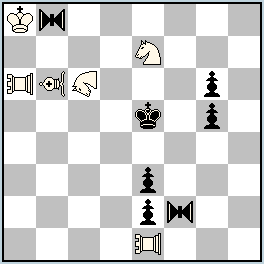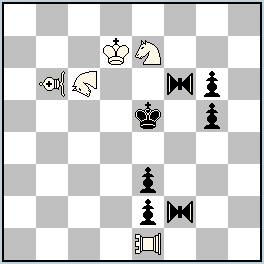| No.259, 259.1 Gani Ganapathi (India) |
Original Problems, Julia’s Fairies – 2013 (I): January – April →Previous ; →Next ; →List 2013(I) Please send your original fairy problems to: julia@juliasfairies.com |
No.259 by Gani Ganapathi – Interesting battery creation! (JV)
No.259.1 by Gani Ganapathi – Improved version of No.259, after comments by Nikola Predrag! (JV)
Definitions:
PAO(PA): Moves as Rook, but captures only by hopping over a hurdle to any square beyond.
VAO(VA): Moves as Bishop, but captures only by hopping over a hurdle to any square beyond.
NAO(NA): Moves as Leo, but on Nightrider-lines instead of Queen-lines.
Nightrider(N): A Rider along a straight line on squares lying a Knight`s move away from each other.
Equihopper (Standard English type): Hops on any straight line (joining square midpoints) to an equal distance beyond a hurdle. Interference and pinning effects are possible on the line.
|
No.259 Gani Ganapathi
India
original-20.02.2013
 h#2 2 solutions (6+7)
Equihoppers: b8,f2 PAOs: a6,e1 VAO b6 NAO c6 Solutions: (click to show/hide)
|
No.259.1 Gani Ganapathi
India
Version of No.259 – 23.02.2013
 h#2,5 2 solutions (5+7)
Equihoppers: f2, f6 PAO e1 VAO b6 NAO c6 Solutions: (click to show/hide)
|



Interesting contrast of white’s first and second move. Both times black’s help is needed, but differently. It is nice that specific mating move is needed due to need for guarding f4.
No.259 shows nice geometry, w/b pieces of different hopping abilities play to the same squares (h6/h8). Pity that bPg6 does not serve as a hurdle for both b&w pieces like bPg5. It is nice that wNAc6 and bEQb8 are used as reciprocal hurdles, but this is not presented as thematic since there is no such reciprocity in the other phase. Therefore, this nice feature might be abandoned if some other thematic reciprocity in the mechanism could be achieved.
Indirect double-battery on the 6th rank looks appealing, wPAa6 is a rear piece and wVAb6/NAc6 reciprocate their functions as the front piece/hurdle. But the rear piece and the respective hurdle in each phase are passive. Passive functions provoke the question: Is it necessary? The immobile parts of a mechanism may look nice but they are strategically inferior as artificial, in principle.
Are those 3 white fairy pieces well justified? Vao and Nao play beatifully, but each of them plays only in one phase. In the respectively other phase their fairy nature is absolutely superfluous.
– wVAb6 and wNAc6 show great weakness, each in one phase.
wPao a6 is a static rear piece but becomes activated by the play of a front piece. The firing of indirect battery might be a justification for a fairy piece but here, a rather artificial one.
– wPAa6 is at least a potential weakness.
By removing wPAa6 and bPg6 from the board and by placing wRg6, the solutions remain the same and Nao/Vao become respectively unnecessary for the play and mate, each in one phase.
Could that weakness of Vao and Pao be ammended by introducing a 3rd white fairy piece, which is potentially a new weakness? Or, do those “weaknesses” justify each other? Various opinions might be expected.
Personally, I would try to reduce the weaknesses, to highlight the reciprocities in the mechanism and to achieve the best functionality from the pieces on the board. For example:
H#2.5; 2 sol.
W:Kd7,Se7,VAb6,NAc6,PAe1
B:EQf6,Pg6,Ke5,Pg5,Pe3,Pe2,EQf2
1…NAb8 2.EQ2d4 VAxe3 3.EQh6 VAxh6#
1…VAd8 2.EQ6d4 NAxe2 3.EQh8 NAxh8#
It is nice that WPao a6 could be removed. It was a technical piece used only for guarding. I like the version of Nikola Predrag. While Ganapathi had dual avoidance play on W1 move, now the dual avoidance is on B1 move – equally good. It is also good that the EQ is on f6, making the W1 move less obvious.
Evaluation of the weaknesses might be various, depending on different approaches. As more important, I wish to hightlight the mechanism. When the Pawns participate in the mechanism, they are not technical pieces, they should be multifunctional like the other parts of the mechanism, static or playing.
bPg6 was the only weakness in the mechanism in the original.
I find Nikola Predrag’s suggestion greatly improves, eliminating the weakness in my problem.
I request Julia thr’ this message to publish his version (H#2.5) as a joint venture with the consent of Nikola.
Dear Gani, your made a realisation, good quite enough to show the beauty of your original idea. White chinese pieces need a hurdle to capture bPs e2/e3, bEQs respectively make a hurdle but the chinese must finally guard flight f4. There are ready hurdels bPs g5/g6 but to get on the other side of them wVA and wNA must have something to capture and the respective sacrifices of bEQs fulfil that purpose. I find that beautiful and I would be happy if I had invented it, but the fact is that the idea is completely yours. I can only cincerely congratulate.
Please do not get me wrong, I would feel like a thief with my name as the coauthor, people would presume that I participated in the creation of that idea and that is simply not true. You are the only one deserving to be the author.
(The mere orchestration can not make me the author of the music)
“(The mere orchestration can not make me the author of the music)” ….. Interesting comparison. I can understand Nikola’s point of view reg. co-authorship. Ganapathi’s offer and Nikola’s gracious words while not accepting it are both fair.
Pardon me for going off-topic. My question is purely about music :). Since I am not a music-buff… I am just curious. Why are music conductors like Zubin Mehta praised when they merely conduct the music of others ?
Ha, the public needs someone to personify a performance of 100 people. Who would remember and praise all those names? And the media live on feeding the fame and glory.
Anyway, the musicians and a conductor are praised for a performance. The composer is usually not much “avaiable” to the media for entertaining the public alive.
Ganapathi has composed an enjoyable piece, he is the author. If he likes the version, I will be happy to see it published with his name only. As Julia once said, she welcomes us all as a host in her home. We talk and exchange opinions and suggestions. My comment with an example should be understood as a friendly opinion and suggestion, not as grabbing the opportunity to participate in the authorship of such a good idea.
Very touched by all these email exchanges – which are a great humbling experience for an 83 – year old problem aficionado like me !
I really enjoy your discussion myself! And I’m happy to see friendly advises, and a processes of development of a better versions (not only here, but in many other cases as well!). I’m happy to see the nice results! Thanks a lot to all participants!
Dear Gani, I’m ready to publish your problem with Nikola’s corrections if this is a final version. In case of any improvements, only the improved version participates in the tournament, so I’d like to ask you if I should add your comments to this version? (you can send them by email as well)
Pawns are often too easily neglected, I surely must be boring with this. bPg5 and bPg6 function as the hurdles. One is for a black and the other for a white piece, which must reach the same square.
These functions are reciprocally changed in the alternate phase.
Well….Ps. e2/e3 also change functions 🙂